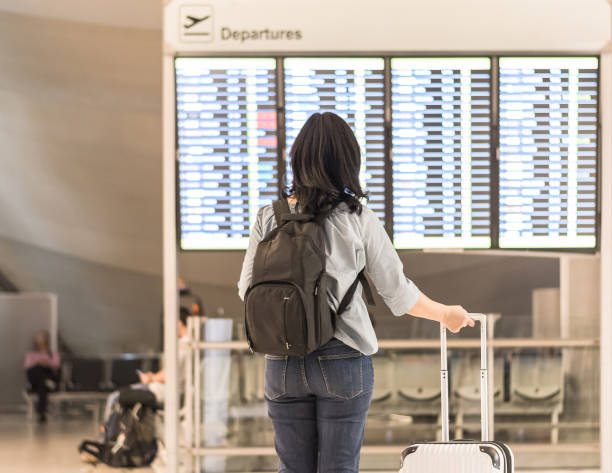Is It Safe to Fly Right Now? Your Coronavirus Questions Answered | Flightlayaway
Many of the airlines that suspended flights during the coronavirus (COVID-19) outbreak are once again returning to the skies. Airlines and airport staff might be doing their utmost to ensure travelers are as safe as possible, but not knowing what to expect when you fly can be worrying. It’s okay to feel torn between the exciting prospect of a relaxing break, while also having doubts and uncertainties about whether it’s safe to travel yet.
Is it safe on a plane?
Air travel can make it more challenging to socially distance and will bring you in contact with shared surfaces. But airlines have put in lots of new procedures in place to help protect passengers and staff, and the risk of flying during COVID-19 might be lower than you think.
According to experts, the risk of a passenger catching coronavirus on a plane is relatively low, as long as the airline and all passengers are following the procedures set out by public health experts — which includes social distancing where possible, wearing face coverings, and washing hands regularly.
The passenger cabin in an aircraft is a unique environment, purposefully designed to mitigate the risk of germs spreading. Most commercial airplanes are fitted with special ‘HEPA’ filters, which are air filters designed for clean air recirculation, and remove almost all airborne particles. According to the Centers for Disease Control and Prevention (the U.S.’s health protection agency), HEPA filters capture 99.97% of airborne particles, substantially reducing the risk of viral spread.
What can I expect
during my flight?
When you board the plane, you’ll find that the airline you’re flying with has put lots of extra measures in place to ensure your safety, including handing out personal protective equipment and asking passengers to socially distance themselves during boarding and disembarking.
Every airline will have different policies in place, but the following is a list of procedures and changes you might find:
1. New cleaning procedures Airlines have notched up their cleaning protocols, with many more thorough deep cleans taking place. Planes will be disinfected between flights and more time might have been allocated to cleaning — in some cases, airlines will take a plane out of rotation between flights. Check the webpage of the airline you’re flying with to find out more about what new cleaning procedures it has introduced.
2. Onboard social distancing Some airlines are keeping the middle seat empty to ensure social distancing policies are adhered to, as well as asking passengers to remain seated unless using the toilets.
3. Personal protective equipment The flight attendants might ask passengers to keep their face masks on during the flight, except for eating and drinking. We recommend that you carry a face covering with you during your journey through the airport and onto the plane, in case wearing one is required.
4. Sanitizing your personal space Many airlines provide passengers with sanitizing wipes or gel. We also recommend that, where possible, passengers also bring sanitizer with them in their carry-on allowance (remember to only carry a small-sized sanitizer, as normal liquid quantity rules apply when passing through security!) so that you can sanitize your seat, tray, armrests, lights, and air-con controls.
5. Reduced catering services If in-flight meals and drinks are complimentary, you might find that the menu has been reduced. Some airlines have temporarily stopped serving warm meals, especially on shorter flights or for passengers in the economy cabin. In premium or business class, meals that are usually served on trays or on china may now be served in disposable containers.
6. Reduced entertainment To help reduce the spread of germs, you may find that personal entertainment screens have been disabled. Alternatively, passengers can carry on their own personal digital devices, such as mobile phones or tablets, in their carry-on allowance to watch entertainment during the flight. On-board duty-free shopping may be temporarily unavailable and in-flight magazines may have been removed.
7. Temperature checks & additional screening This procedure won’t apply to all flights, more likely flights to specific destinations where additional screening, checks, or health declarations are currently mandated by local governments. Before boarding the plane, you may be required to have your temperature checked or to provide verified health documentation. The airline will require all passengers to complete these checks. We recommend that you check with your airline for more information.
8. Contactless check-in & online check-in Some airlines are asking passengers, where possible, to check in online. Many airlines have a dedicated app that can be downloaded; alternatively, once you have checked in online, you can print your boarding pass before you arrive at the airport. If online check-in is not currently available for your flight, we recommend that you arrive at the airport as early as possible, as social distancing may cause delays.
Is it safe at the
airport?
Sitting on the plane is only one stage in your journey, and perhaps one of the safer parts thanks to the incredible technology you’ll find inside the aircraft. Moving through the airport, including check-in, security, waiting, boarding, and disembarking, are all stages that can carry extra risk due to reduced social distancing and potential contact with a larger number of people. But be assured that airports around the world are putting new procedures in place to reduce the risk and keep travelers safe.
There may be different procedures based on the regulations set out by the government of the country you are departing from and arriving at, so it’s definitely a good idea to check online before you head to the airport.
What can I expect at
the airport?
If you plan on flying soon, you may find that your airport experience is slightly different from what you remember from previous trips. You might find that it takes longer to move through the airport, due to social distancing measures, so we definitely recommend arriving earlier than you might normally.
1. Social distancing You might arrive at your departure airport to find that the way you are directed to move around the terminal has changed, as many airports have made modifications to ensure travelers avoid close contact. This might include a new ‘one-way’ system and new queuing markers on the floor. Contactless check-in and contactless drop-off might have been introduced and you may find that some airport restaurants and shops remain shut.
2. Staggered boarding and disembarkation It may take a little longer than you have previously experienced when it comes to boarding and disembarking from your flight. Most airlines have introduced a staggering system when it comes to getting on and off the plane. Each airline will have a policy that works best for the aircraft they are operating, whether that is calling up passengers by seat row or introducing socially distanced queuing. If you’re booking a connecting flight, it will be important to take into account that it may take longer to disembark from the plane when you land.
3. Additional health screening Some airports have introduced additional screening procedures. Some airlines, or the government of your destination, may require passengers to undergo temperature checks before boarding the aircraft. This will likely take place at the boarding gate, so we recommend that you arrive at the gate earlier than you might normally just in case temperature checks have been introduced.
4. Face coverings We definitely recommend that you check the policy of the airports that you will be traveling through because in many instances it’s required, where possible, for passengers to wear face coverings. You’ll also find airport staff wearing personal protective equipment, including face masks and gloves.
5. New cleaning procedures Most airports have ramped up their cleaning procedures, with more staff and time allocated to sanitization. You can also bring your own wipes with you, to clean any seats, tables, doors or other surfaces that you may come into contact with as you move through the airport.
International or Domestic
Is it safe to fly
abroad, or should I choose a ‘staycation’?
‘Staycation’ seems to be the buzzword of the moment, as those looking for a broken switch long-distance holidays with discovering incredible destinations closer to home. By jumping on a quick and easy domestic flight, in no time at all you can be exploring some of the most incredible and secret spots that your home country has to offer.
If you’re moving between regions or states within your home country, remember that state, local and territorial governments might have different travel restrictions in place, which you will need to adhere to. Prepare to be flexible and be aware that changes might need to be made to your travel schedule.
If you’re crossing international borders, check with the destination’s ‘Office of Foreign Affairs’ or ‘Ministry of Health’. The government of your home country will also have an international travel advice page — the ‘Country Information’ page, for example, which is the dedicated advice page set up by the US Department of State, Bureau of Consular Affairs for U.S. nationals traveling abroad.
Fly safely: A quick
checklist
The experience of flying will be slightly different for the foreseeable future due to COVID-19. But don’t let this throw you — follow these simple steps to ensure you remain organized and protect yourself as much as possible when you fly.
1. ‘Is it safe to fly at the moment?’ is an ongoing question
This question is something to be considered both when you book your break, as well as when it’s time to fly. Check your government’s website, as well as the government website of the country you are traveling to, for the latest travel advice and local outbreak updates.
2. Check travel advisories Check the latest travel advisories for any new restrictions that might have been introduced for where your travel is originating from, as well as the destination you are flying to. Check for regulations such as: quarantine on arrival requirements, restrictions on non-essential travel, and changes to documentation requirements including visas and health checks and documentation.
3. Check entry requirements If you’re looking at flying abroad, or even to another domestic state or region, it’s important to check the entry requirements, both before you book and before you fly. You might be required to have been tested negative for COVID-19.
4. Add flight travel insurance to your booking During these confusing times, we definitely recommend adding travel insurance to your booking. When you book your flights through Flightlayaway, you can add flight insurance, which entitles you to a refund if you need to cancel your flights, and gives you extra peace of mind. Find out more about adding travel insurance to your booking.
5. Pre-book your seats There’s already a lot of unknowns about flying at the moment, so by pre-booking your seat you can have a bit of control over what your flying experience will be like. Choose the seat which is most comfortable for you, or perhaps upgrade from Economy to Premium for a bit of extra personal space — the upgrade fee might be less than you might think.
6. Practise the recommended health measures Catching your flight and moving through the airport can be chaotic, but always remember the basics. Stay two meters away from others when possible, avoid touching your face and ensure you remember your personal protective equipment, including face coverings and hand sanitizer.







Comments
Post a Comment